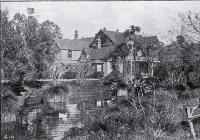
Riccarton Bush is the sole Canterbury remnant of ancient podocarp forest which once covered larger areas of the region. It was also the home of the Deans family, the first European settlers of the Canterbury plains.
Trees in the seven hectare bush include ancient kahikatea, totara, matai and hinau. The bush is now protected by a predator proof fence and is home to small populations of the Canterbury tree wētā and four great-spotted kiwi/ roroa juveniles ranging in age from four to seven months old. The survival of the bush reserve is due to the wish of pioneer settler John Deans. In 1947 the Council purchased Riccarton House and the remaining 1.4 hectares of bush as a public amenity. The bush, Riccarton House, and the Deans Cottage of 1844 (the oldest dwelling on the Canterbury Plains) are central to the European settlement history of Christchurch.
Māori and Riccarton Bush
Before European settlement, Pūtaringamotu was a valuable source of food and timber for the Māori. From the bush they produced carvings and canoes, and preserved pigeons.
These trees, up to 600 years old, are the descendents of a podocarp forest established over 6000 years ago. They are the sole Canterbury remnant of kahikatea floodplain forest and as such have national significance.
Significance of Riccarton Bush

Riccarton Bush is probably the oldest protected natural area in the country. It is a reminder of what the Canterbury Plains would have looked like before human settlement. The trees are mostly kahikatea (between 400 and 600 years old), totara, matai, kowhai, hinau and other species. Native climbing plants and a wide range of ferns and mosses are also found there.
The native bird population has dropped in number since the arrival of the European settlers. Fossil records show that kiwi, takahe and moa once lived there. With the clearing of almost three-quarters of the original pre-European bush, the native bird-life declined. The most common birds there now are introduced species, such as sparrows, blackbirds, thrushes and starlings.
Introduced animals have not helped the native bird and insect populations. Australian brush-tailed possums arrived around 1900, 12 hedgehogs escaped from Merivale in the 1890s, rabbits were introduced in the 1850s, and rats (Norway and ship) and mice have been in New Zealand since the beginning of the nineteenth century. They all inhabited the Bush until a predator proof fence was built in 2000 and pests were eliminated.
In 2009 the predator proof reserve became home to four juvenile great spotted kiwi/roroa chicks and is planned to operate as a creche for raising kiwi until they are strong enough to release into the wild. A joint Department of Conservation, Lincoln University and Riccarton Bush Trust project to introduce the Canterbury tree wētā (Hemideina femorata) has been taking place since 2008.
Early European settlement and Riccarton Bush
Riccarton Bush was first seen by Captain Barney Rhodes in 1836 when he climbed the hills from Port Cooper (Lyttelton Harbour) and looked at the plains beyond. It is shown clearly in maps drawn as early as 1845, and in Charles Torlesse’s detailed survey map of Canterbury in 1849. It was a favourite subject of early artists as well.
For the first Pakeha, the bush was a source of shelter and building timber and firewood.
In the 1848 Christmas Day agreement signed between the Deans brothers and the agents for the Canterbury Association, Captain Thomas and William Fox, the Deans gave up half of what was now to be known as Riccarton Bush, to provide timber and firewood for the new settlers.
By July 1851 the Christchurch settlers had cut down all the standing timber in their half of the bush. Papanui Bush was cleared completely by 1861, and other patches of bush at Hoon Hay, Halswell, Tai Tapu, Woodend, Rangiora, Ohoka and Tuahiwi had almost disappeared by 1870.
Deans family
William and John Deans emigrated to New Zealand from Scotland in 1840 and 1842 respectively. They decided to settle on the Canterbury Plains in 1843. Settling near the bush at Putaringamotu, the Deans renamed their area of settlement Riccarton after their home area in Ayrshire, Scotland.
They renamed the river Otakaro the Avon after the Avon Water which had bounded their grandfather’s property in Lanarkshire.
The Deans used the timber in their half of Riccarton Bush carefully. Some kahikatea and matai was used for the framing and weatherboarding of buildings at Riccarton, and later at Homebush, but only fallen or dead timber was used for firewood and fencing.
Twice in the early days of Christchurch fires came close to the Bush. Jane Deans planted introduced trees around the edge of the Bush to protect it from wind. These exotic trees have gradually been removed in recent years.
On his deathbed in 1854, John Deans asked that his wife Jane make sure that Riccarton Bush was preserved forever. In 1914 the Deans family presented the remaining 15.7 acres (6.35 hectares) of Riccarton Bush to the people of Canterbury, on condition that it be preserved for all time in its natural state.
A Board of Trustees was set up according to the Riccarton Bush Act of 1914 and the bush was opened to the public on 24 February 1917. The area around the bush was extended when the Christchurch City Council bought Riccarton House from the Deans family in 1947. The Deans Cottage, the oldest surviving building on the Canterbury Plains, is also sited there.
Deans’ Cottage
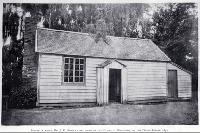
Deans Cottage, a simple robust pioneer cottage, was built by Samuel Manson and William and John Deans. Built from timber cut in Riccarton Bush and pit sawn into boards, the cottage was the Deans’ first home at Riccarton.
William and John lived in the cottage until their untimely deaths. William drowned in the shipwreck of the barque Maria in July 1851. John, who travelled to Scotland in 1852 to marry Jane McIlraith, returned to Riccarton in 1853 and died in the cottage from tuberculosis the following year.
Jane Deans and her son John lived in the cottage until the building of the first stage of Riccarton House was completed in March 1856.
The cottage was originally sited near the Kahu Road Bridge. In 1947 it was shifted from this site and restored by the Christchurch Rotary Club.
In 1970 it was relocated to its present site between the main house and Riccarton Bush with the help of the Riccarton Rotary Club. It contains displays of historic items loaned and assembled by the Canterbury Museum.
Riccarton House
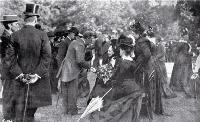
Riccarton House is testimony to the fortitude of John Deans’ wife, Jane, who commissioned the first and second stages of this house. Jane ensured the continuation of the Deans’ settlement in Canterbury after the untimely death of her husband.
In 1856 Jane commissioned the first section of Riccarton House to be built by James Johnson. The two storey section of this house remains as part of the east wing of the present structure. In 1874 a second section was built, and in 1900 a substantial addition designed by the architectural firm of England Brothers was added to accommodate the growing family of John Deans II and his wife, Catherine.
A restoration and conservation programme of Riccarton House had been undertaken by the Riccarton Bush Trust prior to the 2010-2011 Canterbury earthquake sequence. The house was open to the public and was used as a functions and meetings venue and more recently the grounds became the site of the popular Christchurch Farmers’ Market. The house suffered some damage in the earthquakes and has been temporarily closed to the public for repairs. The grounds (including the market), cottage and bushwalks remain open. On October 16, 2012 a $2 million project to repair the house was announced, with completion expected by early 2014.
Riccarton Bush today
Riccarton Bush is administered by the Riccarton Bush Trust which was established by an Act of Parliament in 1914. The Trustees are appointed by the Royal Society, the Deans family, and the Christchurch City Council.
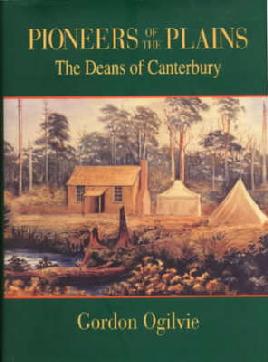 Search our catalogue
Search our catalogue
- Riccarton Bush
- Riccarton House
- Deans, Jane, 1823-1911
- Deans, John, 1820-1854
- Riccarton Bush: a remnant of the kahikatea swamp forest formerly existing in the neighbourhood of Christchurch, New Zealand edited by Chas. Chilton, 1924. Digitised booklet.
- Pioneers of the Plains: the Deans of Canterbury, Gordon Ogilvie. Christchurch, 1996
- Pūtaringamotu Information from Tī Kōuka Whenua
- Part plan of Messrs Deans’ reserve at Riccarton, dated 22 Aug. 1849
- Armagh Street, Christchurch, looking west from the corner of Durham Street 1860
- Articles about Riccarton Bush from the Papers Index
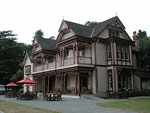 More information
More information
- Riccarton House repairs begin
- Article from the Stuff website, 16 October, 2012
- Riccarton House
- Heritage New Zealand List.
- Riccarton House & Bush
- Riccarton Bush Trust web site.
- Deans Cottage
- Heritage New Zealand List.
- The 1997 Banks Memorial Lecture: History and Management of Riccarton Bush
- Royal New Zealand Institute of Horticulture.
- Deans, William 1817-1851
- Collection of archival material held by the Canterbury Museum, listed on the Community Archive.
- Graham M. Miller and John M. Park. Deans, Jane - Biography
- from the Dictionary of New Zealand Biography. Te Ara - the Encyclopedia of New Zealand, updated 1-Sep-10
- Graham M. Miller. Deans, John and Deans, William - Biography
- from the Dictionary of New Zealand Biography. Te Ara - the Encyclopedia of New Zealand, updated 1-Sep-10
Source
This was originally derived from the Christchurch City Council handbook of 1998.
